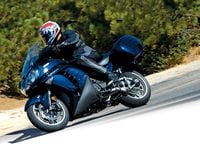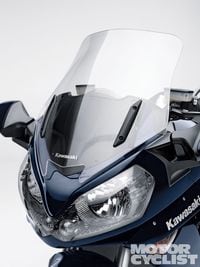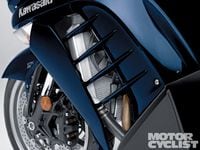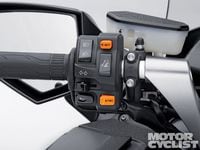To the less perceptive observer, it could pass for a warmed-over version of last year's Concours 14. Given the currently chilly financial climate, we didn't expect many changes for 2010 beneath the fresh coat of Candy Neptune Blue paint. The home office had a more ambitious agenda. When customer research came back with the same list of flaws in the original '08 design, Kawasaki Japan wanted them fixed. All of them.
Handling is instantly familiar to anyone with some seat time on the previous version. A firmer fork gains steering precision but loses compliance on rough pavement. Kawasaki's Tetra-Lever driveline maintains a steady chassis attitude whether you're on or off the throttle. When you're on, the new Bridgestone radials make steering much more neutral, especially over the last few degrees before the peg-feelers touch down. The big four's eerie smoothness becomes a faint buzz above 5000 rpm, but not enough to avoid the high-speed happy place between 4000 and 7000. The last Concours was good enough that we were willing to overlook a few bad habits. Now that they're gone, nobody else's uber-tourer makes us happier.
Concours customers don't like roasting in hot air from the engine bay? The subtly resculpted fairing and bodywork are all-new. Fit and finish are noticeably better as well. They're tired of rough, noisy air in the cockpit? Here's a taller, wider windscreen. Looking to go further between fuel stops? Cue up a high-mileage fuel map with the touch of a button; the same one that lets your left hand cycle through data on the cockpit LCD without leaving the grip. Never saw Officer Obie's Crown Vic on your six? Repositioned rear-view mirrors fix that and steer more oncoming air around your hands as well. Still cold? Don't blow all that dough on a BMW. Heated handgrips are standard. Just in case that's not enough, the optional linked ABS is smaller, lighter and comes with switchable traction control to sweeten the deal.
The big boy looks good soaking up a little Coachella Valley sunshine. Slimmer. More focused. But then again, everything looks a little better when you're 142 miles southeast of L.A., aiming 679 pounds of electronically enhanced sport-tourer at the San Jacinto Mountains. Easing out of Indian Wells-home to more blue hair, millionaires and perfectly preserved German convertibles than anywhere else in America-the new Concours hardly feels that heavy. A whiff of throttle cues up seamless, socially acceptable acceleration from 2500 rpm. Except for providing the inevitable overstuffed Tommy Bahama shirt in a Porsche Carrera Cabriolet with some 7000-rpm enlightenment, anything above 4000 is overkill around town. Shifting is easy, and mostly optional with this torque spread.
After a few miles of stoplights, there's no withering engine heat in the cockpit. Slip into the overdrive top cog and there's no nasty buffeting behind the new windscreen at 80 mph. No vibration either. There are a lot of buttons. Lessee ... KTRC means traction control. Dial up too much throttle across some sandy desert intersection and it dials down power just enough to keep the rear wheel from spinning. Otherwise, you'll never know it's there. The orange K-ACT button toggles between linked braking modes: Standard works best for all-round and sporting duty. High Combined Mode engages more of the four-pot Nissin front calipers and 310mm discs when you toe the right pedal-enough to stop hard with no help from the front brake lever. A healthy squeeze on said lever whilst mashing the pedal uncorks enough pure deceleration to rearrange internal organs. The ABS only kicks in when there's not enough grip to execute your orders-a nice digital safety net and especially handy for two-up travel on unfamiliar roads.
Purists insist they're the only acceptable link between a motorcycle's front and rear brakes. For everyone else, the Kawasaki electronics make slowing down easier. Use two fingers on the lever and that assistance is subtle-just enough rear brake to compress the suspension at both ends instead of just the fork. No disconcerting forward pitch. Nice. A little more pressure on the lever equals a lot more stopping power. Perfectly linear it's not. Cornering with one toe on a normal brake pedal usually cures mid-corner chassis fidgeting, but this one adds just enough front brake to make things worse, even in Standard mode. But that's the only concession to Concours technology you're likely to make. Otherwise, the brakes are stellar.
2010 Kawasaki Concours 14
Hard Parts
Even more techno-trickery for the touring Ninja
Rolling Stock
Those 10-spoke aluminum wheels roll over from last year's Connie, but the Bridgestone BT-021U radials make steering much more linear, though it's still a bit slow. Kawasaki say's they'll last longer, too. ABS is optional once again, adding $700 to the sticker price. This time a lighter, more compact ABS system links front and rear brakes, and KTRC traction control is part of the deal. Kawasaki Advanced Coactive Braking Technology (K-ACT) is an electronically governed dual-mode system. Stop the bike and a switch on the left bar lets you choose between two modes. The sportier Low Combined setting is designed to deliver a sporting level of front brake when you step on the pedal. High Combined mode puts progressively more front brake under your right foot. The front brake lever's effect on the rear disc is the same in either mode. An icon in the LCD dash shows the current mode.
Chassis
Peel away the 2010 plastic and you'll see an aluminum-monocoque skeleton carried over from the '08 Concours 14, which is in turn a stronger version of the '06 ZX-14 frame. Like Kawasaki's first monocoque streetbike, the 2000 ZX-12R, this one is relatively narrow between the knees. The downside? It's a bit top-heavy, too. The 43mm fork legs are the same on the outside, but each one carries 25 milliliters (.84-ounce) more oil than last year for more precise steering and extra stability at speed.
Engine
The ZX-14-derived 1352cc four is essentially a transplant from the '08-'09 model. Dual balance shafts allow solid engine mounts. Hydraulically variable valve timing fattens the power curve from 4000 to 6000 rpm without letting thrust flatten out on top. The diaphragm-type slipper clutch uses coil springs to stifle driveline slack. A quartet of links in the Tetra-lever swingarm keeps all that torque from jacking up the rear suspension when you're on the gas or squatting on its haunches when you roll off. This time, Kawasaki Traction Control (KTRC) is on the case, constantly comparing wheel-speed data from the ABS sensors. Spin the rear faster than the front and it dials back fuel delivery, intake airflow and ignition timing to match power output with available traction, regardless of how far you twist the throttle. KTRC activates when the engine starts, but you can turn it off-or back on-with a switch on the left bar, on the fly.
An ECO indicator in the LCD cockpit comes on whenever the engine is sipping super unleaded efficiently. Switching to ECO-mode takes conservation measures one step further, cuing a leaner fuel map in the fuel-injection ECU, potentially increasing fuel mileage by up to 25 percent. It works in any gear, but all systems revert to normal above 6000 rpm, 30 percent throttle or 80 mph.
Comfort
Extensive analysis of Computational Fluid Dynamics data yielded bodywork that dispenses with engine heat more efficiently and directs it away from the rider. The 2010 fairing flares out further on either side. New panels close the engine/fairing gap while larger side vents give hot air a more convenient escape route. No more slow-baked shins.
The electrically adjustable windscreen is 2.75 inches taller and wider at the top to nix buffeting and wind noise at freeway speeds. New vents on either side of the instruments balance low-pressure air and subsequent turbulence inside the cockpit. Mirrors ride 1.6 inches higher to provide a better rear view and steer more wind around your hands. Heated grips are standard for 2010, adjustable via a knob just below the new storage compartment below the left grip. An electromagnetic lock secures it above 25 mph, or when the ignition is switched off.
The Kawasaki Intelligent Proximity Activation System (KI-PASS) is back, automatically awakening the ignition and other vital electronics with a pocket-sized fob when you're within 5.25 feet of the bike and powering down 3-4 seconds after you step away. Since losing said fob can ruin your day, the 2010 Concours comes with a smaller secondary fob with a 4-inch range so you can stash it in your luggage. New hooks toward the rear of the cockpit make securing a tank bag easier.
tech
Spec
Evolution
Introduced in '08 as an interstate ZX-14, the Concours has been infused with a laundry list of enhancements calculated to leave lesser sporty-tourers behind.
Rivals
BMW K1300GT, Honda ST1300, Yamaha FJR1300.
Contact
Kawasaki Motors Corp. USA
9950 Jeronimo Rd.
Irvine, CA 92618
949.770.0400
www.kawasaki.com
Verdict 4.5 stars out of 5
The best touring bike two years running is suddenly a whole lot better.
















/cloudfront-us-east-1.images.arcpublishing.com/octane/HXOUJXQWA5HBHGRO3EMJIGFMVI.jpg)

/cloudfront-us-east-1.images.arcpublishing.com/octane/3TIWWRV4JBBOLDVGRYECVVTA7Y.jpg)
/cloudfront-us-east-1.images.arcpublishing.com/octane/KIX5O23D5NAIBGFXBN3327DKZU.jpg)
/cloudfront-us-east-1.images.arcpublishing.com/octane/7GJYDUIPXRGMTMQKN6ONYOLBOU.jpg)
/cloudfront-us-east-1.images.arcpublishing.com/octane/MUQLOVLL2ZDGFH25ILABNBXKTI.jpg)
/cloudfront-us-east-1.images.arcpublishing.com/octane/TNOU5DNE2BC57MFPMGN2EIDXAM.jpg)
/cloudfront-us-east-1.images.arcpublishing.com/octane/GTCXACQGJ5HAPDTGWUQKDEH44E.jpg)
/cloudfront-us-east-1.images.arcpublishing.com/octane/S35YGSEMEZB4BLTDJTSZPF4GLA.jpg)
/cloudfront-us-east-1.images.arcpublishing.com/octane/5UOT6HPX2JFMRJAX6EH45AR4MQ.jpg)
/cloudfront-us-east-1.images.arcpublishing.com/octane/OKWOJWAKP5EP3OACCRRWPCIX2Q.jpg)
/cloudfront-us-east-1.images.arcpublishing.com/octane/2WF3SCE3NFBQXLDNJM7KMXA45E.jpg)
/cloudfront-us-east-1.images.arcpublishing.com/octane/G4MG6OUCJNBSHIS2MVVOTPX65E.jpg)
/cloudfront-us-east-1.images.arcpublishing.com/octane/IIGGWFOTOJGB7DB6DGBXCCMTDY.jpg)
/cloudfront-us-east-1.images.arcpublishing.com/octane/QSTCM6AVEZA5JJBUXNIQ3DSOF4.jpg)
/cloudfront-us-east-1.images.arcpublishing.com/octane/U4I7G625B5DMLF2DVIJDFZVV6M.jpg)
/cloudfront-us-east-1.images.arcpublishing.com/octane/B6XD6LS6IVCQPIU6HXDJSM3FHY.jpg)
/cloudfront-us-east-1.images.arcpublishing.com/octane/ICL63FEDDRDTTMINYICCEYGMDA.jpg)
/cloudfront-us-east-1.images.arcpublishing.com/octane/FCGZHQXRBZFLBAPC5SDIQLVF4I.jpg)
/cloudfront-us-east-1.images.arcpublishing.com/octane/WNOB6LDOIFFHJKPSVIWDYUGOPM.jpg)

/cloudfront-us-east-1.images.arcpublishing.com/octane/X33NU3E525ECRHXLNUJN2FTRKI.jpg)
/cloudfront-us-east-1.images.arcpublishing.com/octane/6KKT5NNL2JAVBOXMZYS5ZO76YA.jpg)
/cloudfront-us-east-1.images.arcpublishing.com/octane/J5RKG5O455GMPGQRF2OG6LRT7A.jpg)